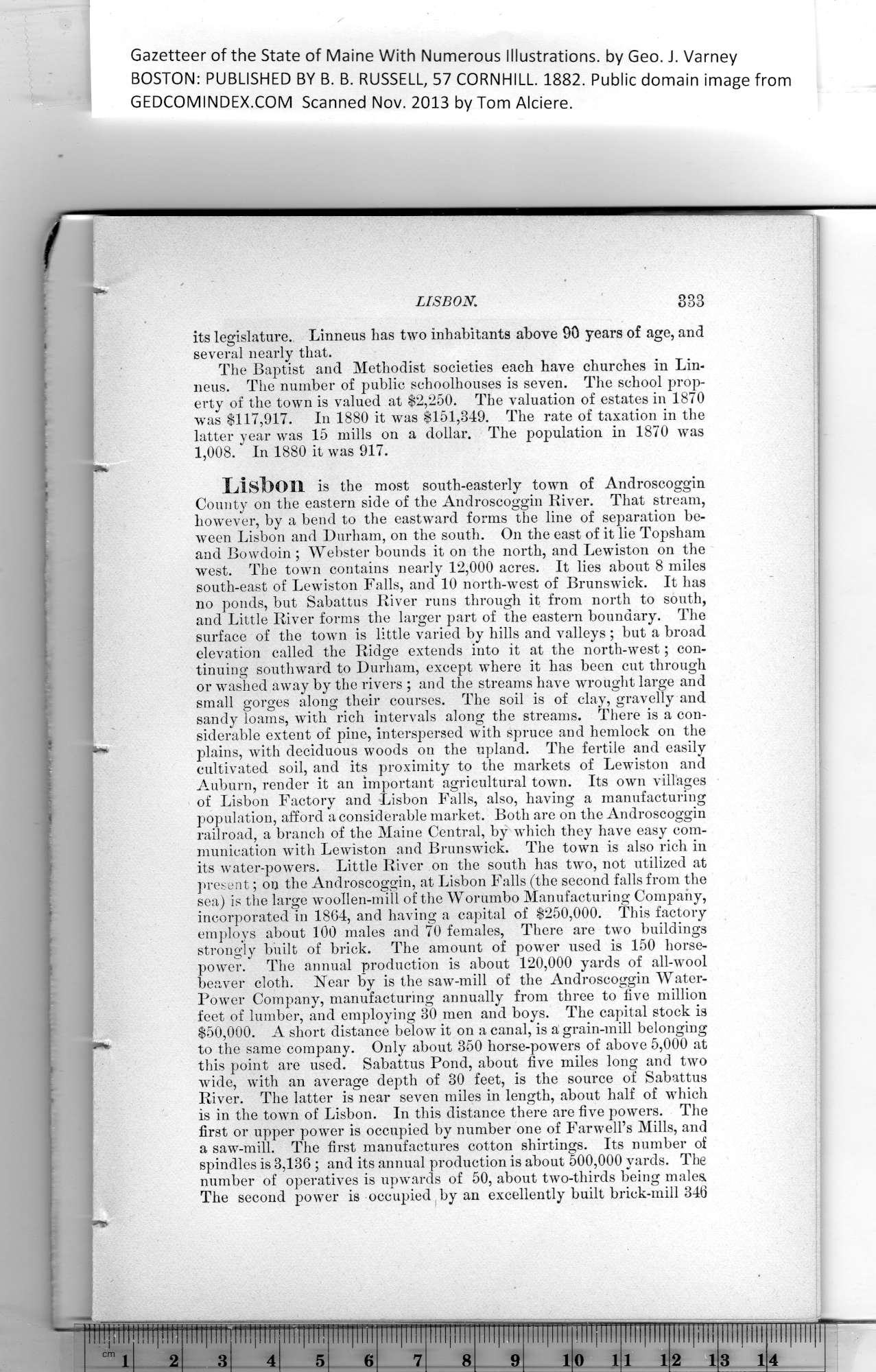|
Gazetteer of the State of Maine With Numerous Illustrations, by Geo. J. Varney
BOSTON: PUBLISHED BY B. B. RUSSELL, 57 CORNHILL. 1882. Public domain image from
LISBON. 333
its legislature. Linneus has two inhabitants above 90 years of age, and
several nearly that.
The Baptist and Methodist societies each have churches in Lin-
neus. The number of public schoolhouses is seven. The school prop-
erty of the town is valued at $2,250. The valuation of estates in 1870
was $117,917. In 1880 it was $151,349. The rate of taxation in the
latter year was 15 mills on a dollar. The population in 1870 was
1,008. In 1880 it was 917.
Lisbon is the most south-easterly town of Androscoggin
County on the eastern side of the Androscoggin River. That stream,
however, by a bend to the eastward forms the line of separation be-
ween Lisbon and Durham, on the south. On the east of it lie Topsham
and Bowdoin ; Webster bounds it on the north, and Lewiston on the
west. The town contains nearly 12,000 acres. It lies about 8 miles
south-east of Lewiston Falls, and 10 north-west of Brunswick. It has
no ponds, but Sabattus River runs through it from north to south,
and Little River forms the larger part of the eastern boundary. The
surface of the town is little varied by hills and valleys ; but a broad
elevation called the Ridge extends into it at the north-west; con-
tinuing southward to Durham, except where it has been cut through
or washed away by the rivers ; and the streams have wrought large and
small gorges along their courses. The soil is of clay, gravelly and
sandy loams, with rich intervals along the streams. There is a con-
siderable extent of pine, interspersed with spruce and hemlock on the
plains, with deciduous woods on the upland. The fertile and easily
cultivated soil, and its proximity to the markets of Lewiston and
Auburn, render it an important agricultural town. Its own villages
of Lisbon Factory and Lisbon Falls, also, having a manufacturing
population, afford a considerable market. Both are on the Androscoggin
railroad, a branch of the Maine Central, by which they have easy com-
munication with Lewiston and Brunswick. The town is also rich in
its water-powers. Little River on the south has two, not utilized at
present; on the Androscoggin, at Lisbon Falls (the second falls from the
sea) is the large woollen-mill of the Worumbo Manufacturing Company,
incorporated in 1864, and having a capital of $250,000. This factory
employs about 100 males and 70 females, There are two buildings
strongly built of brick. The amouut of power used is 150 horse-
power. The annual production is about 120,000 yards of all-wool
beaver cloth. Near by is the saw-mill of the Androscoggin Water-
Power Company, manufacturing annually from three to five million
feet of lumber, and employing 30 men and boys. The capital stock is
$50,000. A short distance below it on a canal, is a grain-mill belonging
to the same company. Only about 350 horse-powers of above 5,000 at
this point are used. Sabattus Pond, about five miles long and two
wide, with an average depth of 30 feet, is the source of Sabattus
River. The latter is near seven miles in length, about half of which
is in the town of Lisbon. In this distance there are five powers. The
first or upper power is occupied by number one of Farwell’s Mills, and
a saw-mill. The first manufactures cotton shirtings. Its number of
spindles is 3,136 ; and its annual production is about 500,000 yards. The
number of operatives is upwards of 50, about two-thirds being males
The second power is occupied by an excellently built brick-mill 346
PREVIOUS PAGE ... NEXT PAGE
This page was written in HTML using a program written in Python 3.2
|
